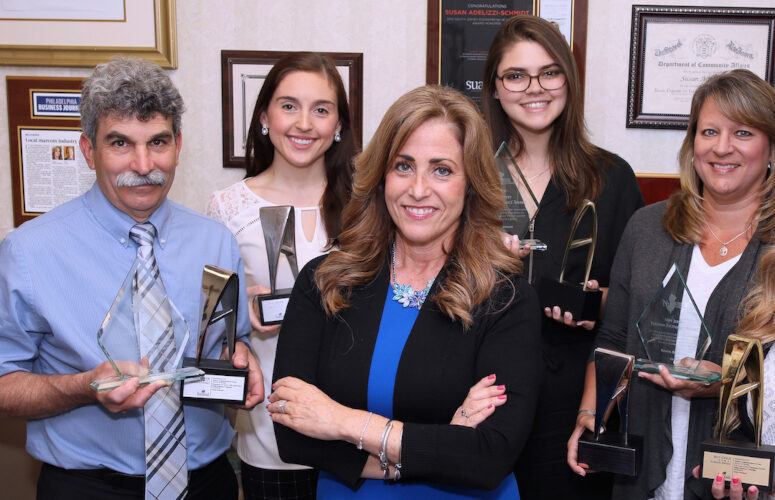
Walters Group Receives LEED Certification for Two Camden County Projects
On Jun 8, 2016Walters Group, a residential and commercial developer, has been awarded LEED® Gold certification established by the U.S. Green Building Council for Albertson Village Apartments in Haddon Township and LEED® Silver for its 8,000-square-foot office building at 21 Euclid Ave. in Haddonfield.
Both of these residential and office buildings in Camden County are visible examples of Walters Group’s long-term commitment to building green and being environmentally responsible. The developer went above and beyond basic LEED certification for both projects. Albertson Village, an 82-unit luxury apartment project, received 77 points, which is over the 74 required to attain LEED Gold certification. The office building at 21 Euclid Avenue scored 53 points of the 50-59 required to earn the LEED Silver designation. Minno & Wasko, with offices in Lambertville and Newark, New Jersey, served as the lead architect on both projects.
“The basic outcome of pursuing LEED on projects like these is to create an environment that is healthier, more efficient and comfortable as compared to code built or existing construction,” said Jon Jensen, sustainability director for MaGrann Associates, energy efficiency and green consultants who assisted Walters with the LEED process. Headquartered in Mount Laurel, MaGrann has worked with Walters to complete six LEED certified commercial and residential projects.
“Sustainable development is about creating a better building which is at the core of our corporate philosophy,” said Ed Walters, Jr., president and founder of Walters Group. “Although there are incremental costs involved in building green, we see it as investing in a higher quality product that in the long run makes good sense.”
LEED (Leadership in Energy and Environmental Design) is the preeminent ratings program, which works for all buildings — from homes to corporate headquarters, according to the USGBC. Qualified buildings are given certified, silver, gold, or platinum ratings that represent ascending levels of environmental sensitivity and energy efficiency.
One of the biggest hurdles in the LEED program is meeting all of the prerequisites, according to Jensen. These prerequisites have to be met before points can begin to accrue to reach a desired certification level. Before a project can be LEED certified, it must also go through some extra measures such as commissioning, a testing and a verification process to identify any performance issues.
In both the residential and office projects, Walters Group included many sustainable design, environmental and innovative elements and practices within the design and construction plans.
Earning Points for LEED
To become LEED Gold certified, Albertson Village met rigorous technical requirements including a home energy (HERS) rating of 58, 27 percent better than the maximum 85 for LEED. The lower the HERS score, the more energy efficient the home. “This primarily translates into savings for residents,” said Jensen. “Walters does not recuperate any of those savings. They are simply making it an attractive place for residents to live.”
Other key elements for Albertson Village included high-efficiency fixtures to conserve water and a highly efficient irrigation system. In addition, the use of recycled materials in the foundation and insulation amounted to almost 80 percent of construction waste being diverted from the landfill. Walters earned points in the indoor air quality section by having a third party test the ventilation system to confirm it is working as designed, according to Jensen. “You’d be surprised how many ventilation systems in new buildings are not working appropriately,” he added.
The Euclid Avenue office building earned 12 points for its Optimized Energy Performance, according to Karen O’Brien, LEED AP consultant for Consilience, LLC, Washington, D.C. The office project earned another 4 points for water efficient landscaping since all the vegetation planted is native to the area, making it a more sustainable choice. Finally, the location of Albertson Village was as important as the construction, winning the project 7 points for being within walking distance of a commuter rail station. It earned another 6 points for its proximity to nearby services, including healthcare, government agencies, grocery stores, restaurants, etc.
“LEED awards credits for ‘community connectivity’,” said O’Brien. “Access to community resources cuts down on traffic, air pollution and greenhouse gases. It also makes new infrastructure unnecessary, and the need for large parking capacity can be downsized.”
In Ocean County, Walters Group has earned LEED certification for Stafford Park, Stafford Preserve, Whispering Hills Townhomes, Whispering Hills Apartments and Laurel Oaks Apartments. Walters Group is also planning the development of eight affordable housing projects in Ocean and Burlington Counties.
The Walters Group is a leading residential and commercial real estate developer with offices in Barnegat and Haddonfield. Founded in 1984, the privately held company has built residential custom homes, planned communities, multi-family, affordable housing and student housing projects.
Related Articles:





